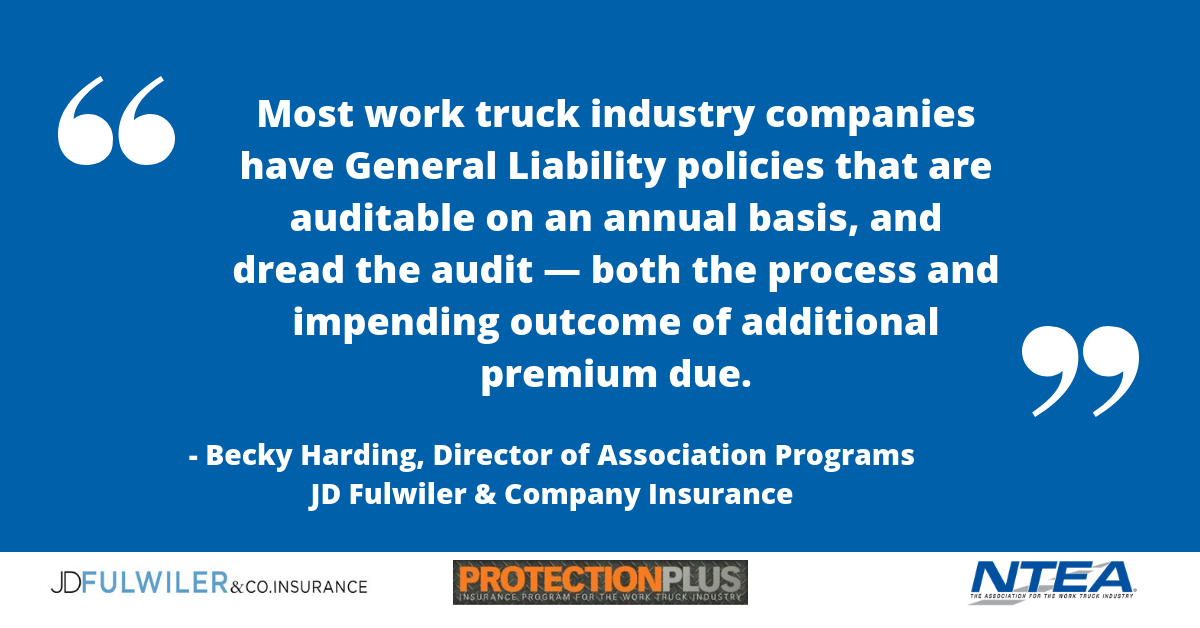
Guest editorial
By Becky Harding, Director of Association Programs, JD Fulwiler & Company Insurance
This article was published in the July 2018 edition of NTEA News.
Most work truck industry companies have General Liability policies that are auditable on an annual basis, and dread the audit — both the process and impending outcome of additional premium due.
So, let’s review the purpose of the audit, the process and how to potentially avoid an unwanted and unexpected bill from your insurer at the end of it all.
The purpose of the audit is for the insurer to collect premiums commensurate to your operation’s exposure. Not unlike the Workers Compensation audit, the General Liability audit is a mechanism to show what your actual exposure was for the policy term.
General Liability policies are written in the beginning of the term with an estimate from you of either your sales (used most commonly, and in the example in this article) or payroll, depending on how your operations are classified. Of course, there is no way to know what your sales or payrolls will be for the upcoming year.
For example, as an upfitter, you likely sit with your agent at renewal time and estimate gross sales for the coming year. The policy is rated and written based on those estimated gross sales. Then, at the end of the year, the insurer will inquire as to what your actual sales were for the term. If higher than estimated, you’ll get a bill for additional premium. Conversely, if sales were lower, you’ll receive a return premium. (Note that not all insurers return premium when the latter occurs. Some are auditable “upward” only. This is a good question to ask your agent before signing up with a particular insurer.)
The audit process typically takes one of two forms. One is the written audit, during which you receive a form to fill in with your actual sales and return to the insurer. The total is calculated, and you are informed of the outcome. The more common way is an in-person audit where an auditor comes to your facility, reviews your books with you and completes the audit form based on findings. The auditor then submits the form to the insurer for calculation, and you are informed of the outcome. When you receive the final audit, after all calculations are made, you should end up with a form that basically says, “This is what you paid and this is what you should have paid.” In a perfect world, this would result in a credit back to you each year. Unfortunately, it usually ends up as a bill for additional premium.

There are ways to avoid being caught off guard by a large additional premium.
- Meet with your agent and discuss estimated gross sales for the coming year at every renewal. The more involved you are in the process, the more control you’ll have over the outcome. Your sales estimates should be as accurate as possible to avoid additional premium due.
- Understand what information the insurer wants. Using the upfitter example again, auditable sales are always based on gross revenue. This means you can’t deduct your chassis cost from your sales figure. By doing so, you’re essentially deducting your cost of goods sold and therefore providing the insurer with gross profit, not gross revenue. This will be caught at audit, and the additional premium generated by this type of error can be substantial.
- Communicate with your agent throughout the year if your sales swing drastically in either direction. Your agent should be able to go to the insurer during the policy term and amend estimated sales to your revised forecast. This can help you avoid a big bill at the end of the policy term by breaking up your additional premium in small amounts over your monthly installments. But, most importantly, if it appears your sales will be much higher than originally estimated, your rate/$1,000 could actually decrease. Many policies’ rates are lowered as sales increase. So, by accurately amending your sales to a higher figure, your agent can often negotiate a lower rate for you. Then, even if you’re still audited at the end of the year and receive an additional premium, the rate by which it’s calculated is lower — resulting in a decreased audit bill than if your agent had not negotiated down the rate.
The audit process is inevitable — but it doesn’t have to be as bad as you think. Talk with your agent, learn the process and get more control over the outcome.
As NTEA’s preferred insurance agency, JD Fulwiler developed the Protection Plus program to provide the industry with underwriting, risk assessment and loss prevention services. JD Fulwiler will shop among many top insurance carriers with which it does business to find a coverage solution that best meets your needs. Learn more about this program at ntea.com/partnerships or call 800-441-6832.